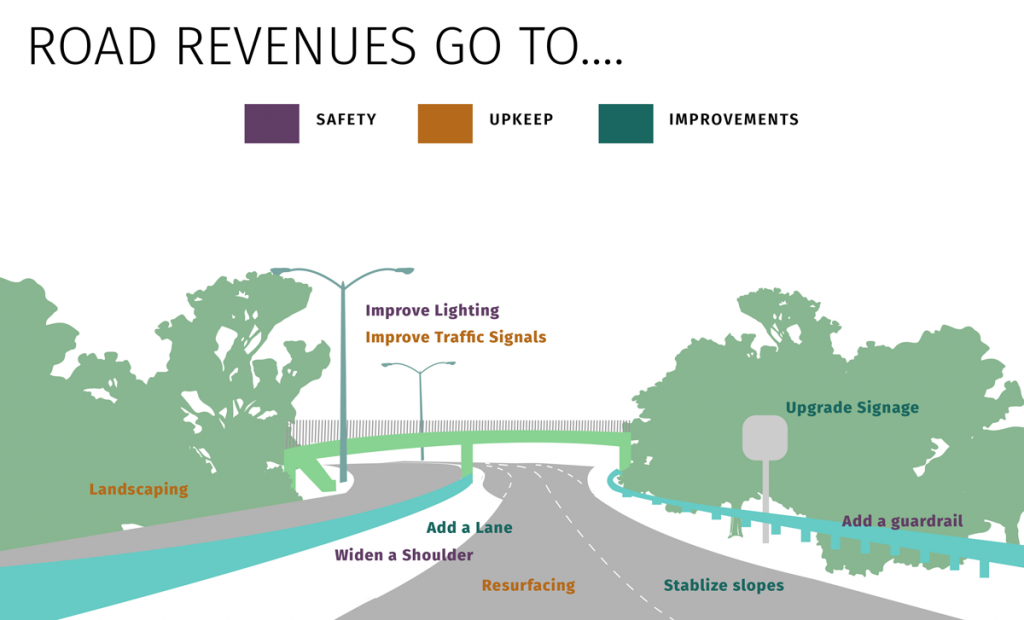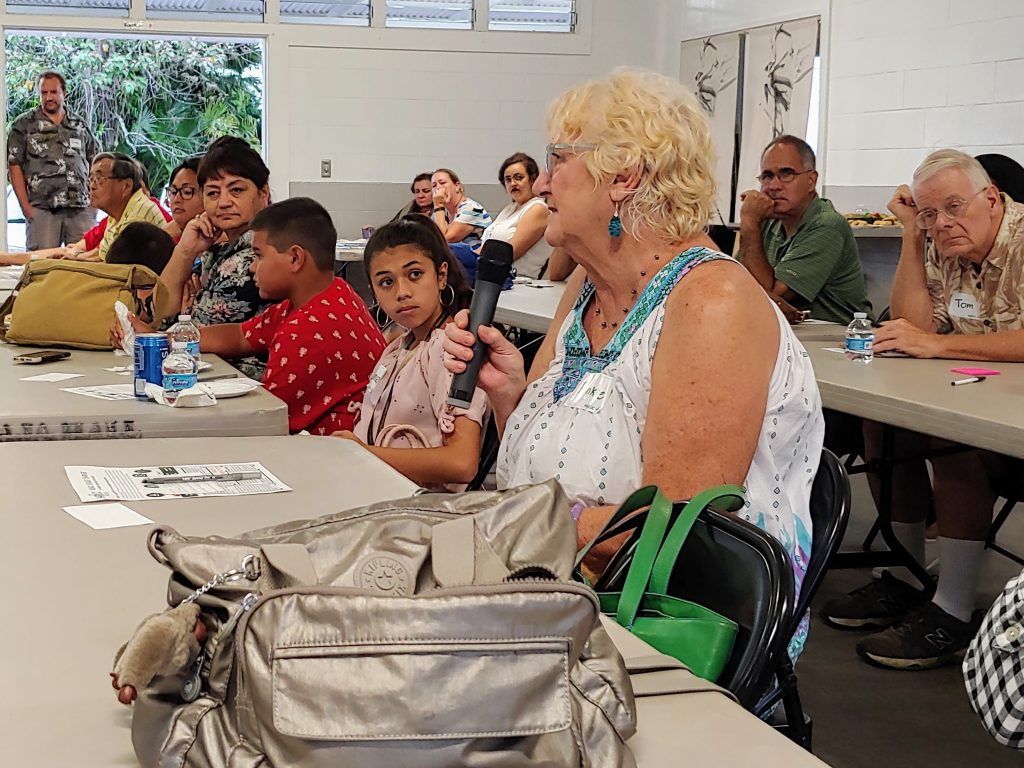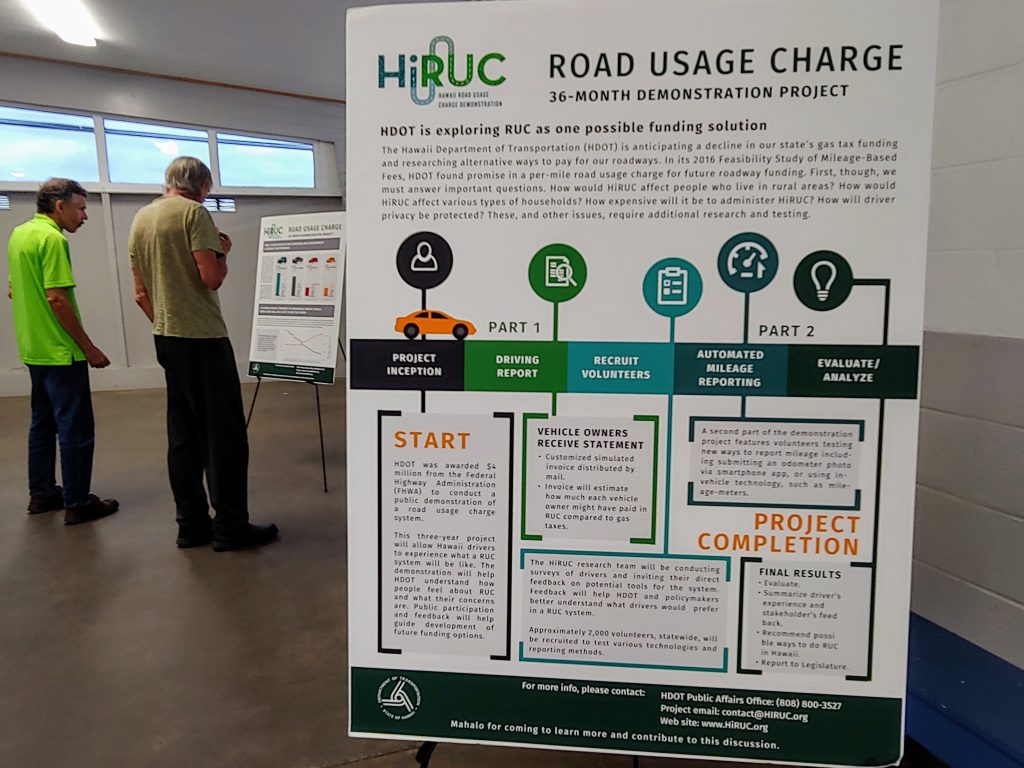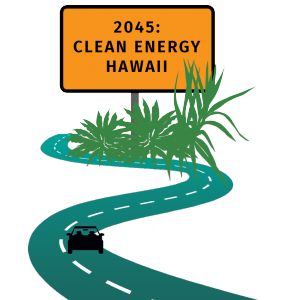Big Island Residents Express Concerns Over Road Usage Charge

Hawai‘i Department of Transportation Road Usage Charge demonstration at AJA Veterans Hall in Hilo, May 9, 2019. PC: Crystal Richard.
East Hawai‘i Island residents expressed concerns over a study to implement a state Road Usage Charge (RUC) during the final meeting on the subject, held by the Hawai‘i Department of Transportation in Hilo on May 9, 2019, at AJA Veterans Hall.
In a RUC system, drivers will pay by the mile, instead of by how much gasoline they burn (gas tax).
The RUC came about as a solution to the decline in gas tax revenue, but also due to the unequal amounts each vehicle pays based on energy efficiency.
According to HDOT, achieving the state’s energy goals will create a road funding system no longer based on use.
“We are here tonight to do research, explained HDOT District Engineer Donald Smith. “No decisions have been made yet, but it’s a way for us to at look for options for the future.”
Smith emphasized this is only a study for research purposes; that feedback is needed and that the RUC would be a replacement for the gas tax.
“We currently pay for our roads through the gas tax,” explained Smith. “Currently, 16 cents of every gallon of gas you put into your car goes into the roadway funds. That amount of money amounts to about $83 million a year.”
Smith said that with the increase of electric and hybrid vehicles, gas tax revenue has declined. He said after many years of growth, the gas tax plateaued for a few years before declining in 2017.
Smith said the plateau is due to all vehicles being more energy efficient.
He said if the state meets its goals of 2054 energy efficiency, the decline in gas tax revenue could drop even further in coming years.
According to Smith, the federal government has recognized that the fuel tax income has declined; the feds are paying $4 million dollars for this study.
He said the HiRUC study is just part of a national effort.
“As vehicles become more efficient, cars are paying less to use the road,” stated Smith. “So, if you drive an electric vehicle, you pay no gas tax. If you drive a hybrid vehicle, you don’t pay as much gas tax. If you drive a large pickup, you are going to be paying more.”

According to the HDOT, on average, a road usage charge would cost drivers about the same as they currently in gas taxes. A typical vehicle at 22 MPG that is driven 15,000 miles a year currently pays $109 in gas tax. HDOT says instead, this vehicle would pay $109 in RUC. A Nissan Leaf, driven 15,000 miles pays zero in gas tax. This owner would experience a net increase of $109. A Prius pays $50 in gas tax, will now pay $109 in RUC, which is an increase of $49 a year. A Ford F-150 pays $141 in gas tax currently, and would now pay $109 RUC, resulting in a net decrease in $39. Making it what HDOT says is a one-to-one replacement.
Smith says the goal of the study is to put forward the challenge the state is facing and actively involve the stakeholders—anyone who drives a vehicle in Hawai‘i.

Hawai‘i Island residents ask questions during HDOT Road Usage Charge meeting in Hilo, May 9, 2019. PC: Crystal Richard.
During the public meeting in Hilo, the more than 30 residents in attendance asked questions and expressed concerns about how a road usage charge would work if implemented.
Many residents expressed concerns over the impacts a road usage charge could have on struggling ‘ohana who already live paycheck to paycheck.
Some expressed concern over there being only one idea proposed, the RUC, rather than multiple options.
However, other options to fund road maintenance include an increase in vehicle registration, charging weight fees, increasing the gas tax, increasing sales taxes, toll roads or diverting state funding from other programs.
The most frequently raised concern was over the impacts the HiRUC would have on those who commute long distances each day. Many pointed out that on the Big Island, commutes are generally much longer than anywhere in the state.
Smith said a very common concern expressed at all the meetings, especially in Hilo, was over the burden of paying an “additional chunk of money.”

East Hawai‘i residents ask questions and voice concern during final HDOT Road Usage Charge meeting in Hilo, May 9, 2019. PC: Crystal Richard.
Some suggested that those who have the money to buy an energy efficient car, have the means to pay more.
“I agree we should pay our fair share for the roads because we use the roads, but please be compassionate,” said Big Island resident and electric car owner Renata Walczuk.
She said electric cars make up less than 1% of vehicles in the state. There approximately 8,000 EVs in the state.
Walczuk said electric car owners are paying for expensive cars, added fees at registration and taxes on their electric vehicles to show leadership. She said that HDOT was presenting just one solution when there should be more options.
The study does not include diesel or commercial vehicles. Residents argued by not including them, the results of the study would be incomplete. HDOT said that because there has been no decline in diesel tax revenue, it is not included in this study. Multiple residents pointed out that commercial vehicles, especially big rigs, cause the most wear and tear on public roads.
One Puna resident asked how the mileage would be tracked, given that many residents drive on private roads as well as public.
HDOT said there are GPS devices and apps that can be used to track whether miles are logged on private or public roads.
Many who live in Puna do so because it is an affordable area live, but it requires commuting to work, school and for most services. Residents fear a RUC would negatively impact those already making sacrifices to just survive.
Some Hawai‘i Island residents asked how tourists would be included in paying their fair share of the HiRUC, which had also been brought up at previous RUC meetings.

East Hawaii residents ask questions and voice concern during final HDOT Road Usage Charge meeting in Hilo, May 9, 2019. PC: Crystal Richard.
Although Smith said this is just a “Study, Study, Study,” when asked if the federal government can require the state to implement the RUC, Smith said, “I don’t know.”
One thing everyone could agree upon is that roads are important. They connect people to their jobs, their communities and their lifestyles.
One resident pointed out that for those living on Hawai‘i Island, there are no reliable transportation options available—except owning your own vehicle. Residents said between registration, safety inspection and the cost of living, they simply cannot afford additional fees.
Hawai‘i is not the only U.S. state exploring the idea or already using a road usage charge. The need to replace the declining gas tax revenues with some other reliable funds is a nationwide concern as more energy efficient vehicles hit the streets.
“There is no reason to be disincentivizing electric vehicles,” said one resident. “We need to make a shift in 12 years so my daughter will have a world to grow up in.”
To see how the road usage charge might affect you use, this calculator to see what you are currently paying in gas tax at the pump.
HDOT will be looking for 2,000 volunteers, with 500 of those being from Hawai‘i Island to participate in the HiRUC pilot.

Hawai‘i Department of Transportation Road Usage Charge 36-Month Demonstration at the AJA Veterans Hall in Hilo, May 9, 2019. PC: Crystal Richard.
The next step for HDOT is to spend the next three years studying whether a RUC might work in Hawai‘i. When completed, HDOT will give a report to the gederal government, county officials and to the state Legislature.
Although the Hilo meeting was the last public meeting to be held in this series, Hawai‘i residents who wish to be involved and share their thoughts on a road usage charge are encouraged to complete the HDOT survey.
For more information on the Hawaiæi Road Usage Charge 36-Month Demonstration Project go online.


















